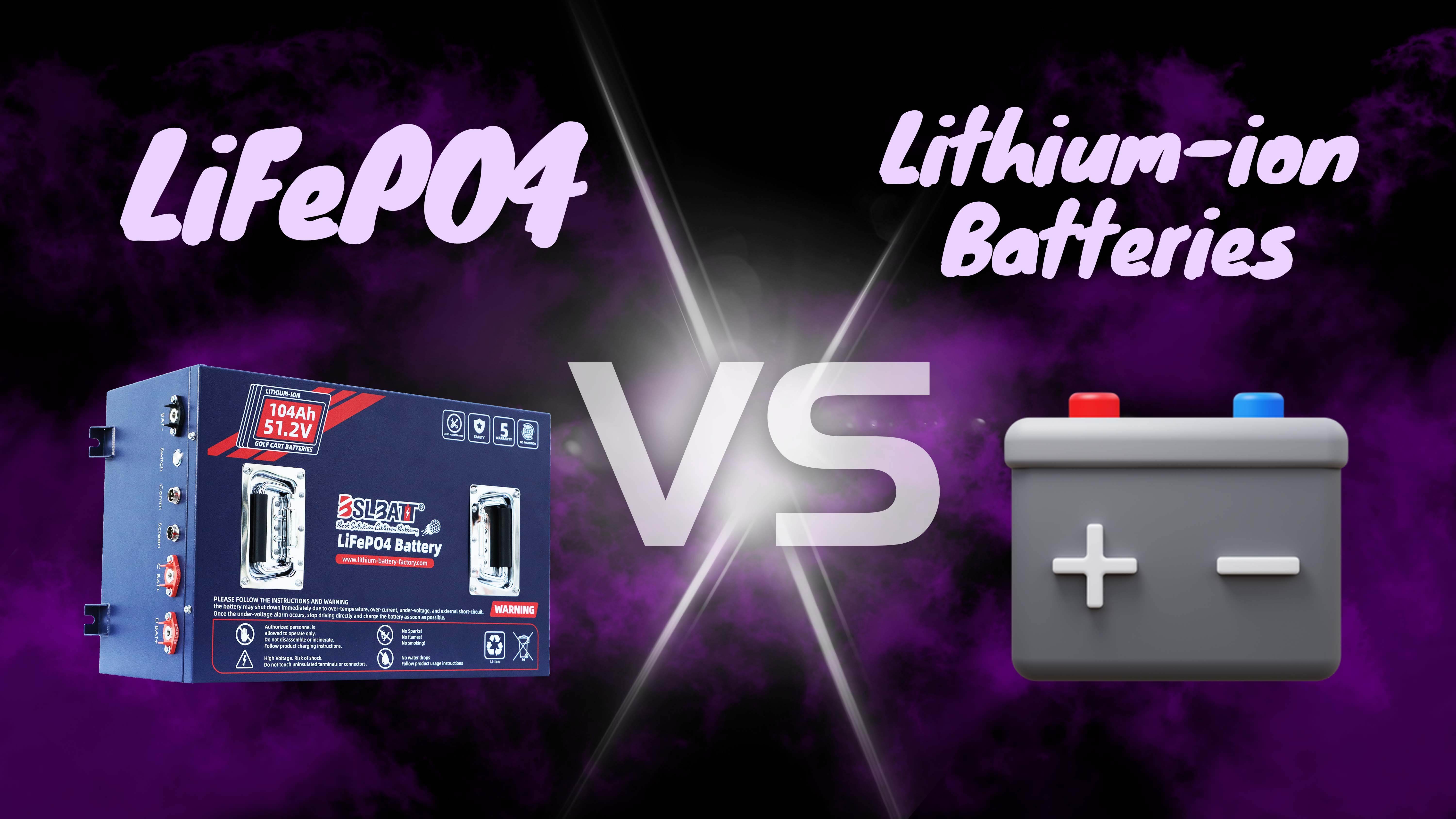Industry Application
Product Type
What are LiFePO4 batteries and why are they the best?
LiFePO4 batteries, or LFP batteries, are rapidly dominating the battery industry. But what does LiFePO4 mean? How do these lithium iron phosphate – LiFePO4 batteries differ from others? It is important not to confuse them with lithium ion batteries.
Read on for more insights into these questions and more.

LiFePO4 Batteries: An Overview
LiFePO4 batteries consist of lithium iron phosphate and are a variant of lithium batteries. Lithium batteries also include:
-
Oxide of lithium cobalt (LiCoO22)
-
lithium nickel manganese cobalt oxide (LiNiMnCoO2)
-
Titanate of lithium (LTO)
-
Oxide of lithium manganese (LiMn2O4)
-
Oxide of lithium nickel cobalt aluminum (LiNiCoAlO2)
Chemistry & Batteries Innovation
Some of these elements may be familiar to you from your chemistry classes. It was here that you spent hours learning the periodic table (or gazing at it on the school wall). You conducted experiments (or pretended to be engrossed in the experiments while actually eyeing your crush).
Occasionally, a student develops a love for experiments and pursues a career in chemistry. The optimal lithium mixtures for batteries were discovered by these chemists.
This is how the LiFePO4 battery was created. (Specifically, by the University of Texas in 1996). The LiFePO4 battery is currently recognized as the safest, most stable, and most reliable lithium battery on the market.
LiFePO4 Battery History
John B. Goodenough and Arumugam Manthiram are credited with the invention of the LiFePO4 battery. It was they who identified the materials used in lithium-ion batteries. As a result of their tendency to short-circuit prematurely, anode materials are not ideal for lithium-ion batteries.

Researchers found that cathode materials are superior substitutes for lithium-ion batteries. In particular, LiFePO4 batteries exhibit this characteristic. The LiFePO4 battery was developed as a result of improvements in stability and conductivity, among other things.
Nowadays, LiFePO4 batteries are ubiquitous. In addition to boats and solar systems, they are used in conventional and electric vehicles.
Cobalt-free LiFePO4 batteries are less expensive than their cobalt-containing counterparts over time. It has a longer lifespan and is non-toxic. We’ll explore this further in the near future. There is a lot of hope for the LiFePO4 battery in the future.
What makes LiFePO4 batteries superior?
LiFePO4 batteries outperform lithium-ion batteries and other lithium batteries, now that we know what they are.
Due to their lower energy density compared to other lithium-ion batteries, LiFePO4 batteries are not suitable for wearable gadgets like watches. Nevertheless, they are the best for solar power systems, RVs, golf carts, bass boats, semi-trucks, and electric motorcycles. Why is that so?
LiFePO4 batteries have a lifespan over four times longer than other lithium ion batteries.
The lithium battery is also the safest type of battery, outperforming lithium ion and other battery types.
In addition to achieving 3,000-5,000 cycles or even more, LiFePO4 batteries can also achieve 100% depth of discharge (DOD). What is the significance of this? It implies that LiFePO4 batteries won’t overdischarge, unlike other batteries.
Additionally, this allows for extended usage. A high-quality LiFePO4 battery will last many years longer than other types of batteries. The batteries are designed to last for approximately 5,000 cycles, which is equivalent to about ten years. As a result, the average cost over time is significantly lower.
LiFePO4 batteries are compared to lithium ion batteries in this chart.

Chemistry that is reliable and consistent
Lithium batteries must be safe. Lithium-ion laptop batteries that have burst into flames have highlighted this fact. LiFePO4’s safety is one of the most significant advantages over other battery types. Among lithium batteries, LiFePO4 is the most safe. It’s the safest of all.
In general, LifePO4 batteries are the safest lithium batteries. In lead acid batteries and most other battery types, lithium iron phosphate does not have the same thermal and structural stability as lithium iron phosphate. Non-flammable and capable of withstanding high temperatures, LiFePO4 is non-combustible. Thermal runaway is not a problem, and the surface remains cool at ambient temperatures.
In the event of extreme temperatures or dangerous situations (such as short-circuiting or collision), LiFePO4 batteries will not ignite or explode. A reassuring fact for RV, bass boat, scooter, and liftgate owners who regularly use deep cycle LiFePO4 batteries.

A safe and eco-friendly environment
Since LiFePO4 batteries can be recharged, they are beneficial to the environment. The benefits they provide to the environment go beyond that, however. Lead acid batteries and nickel oxide lithium batteries are toxic and leaky.
It is also possible to recycle these batteries. Despite this, they do not need to be recycled often since they have a lifespan of 5000 cycles. This means they can be recharged at least 5,000 times. Lead acid batteries last only 300-400 cycles.

Efficiency and performance of the highest quality
In addition to being safe and non-toxic, you want a battery that can deliver high performance.
Is your lawn mower in need of a lithium battery? Please click here.
According to the following statistics, LiFePO4 provides all of these benefits and more:
-
LiFePO4 batteries can be fully charged in less than two hours.
-
Idle self-discharge rate is only 2% per month. In contrast, lead acid batteries have a capacity of 30%.
-
Comparatively longer operational life than lead acid batteries.
-
Power stability: Maintains the same amperage even when battery life is below 50%.
-
Maintenance is not required.
A compact and lightweight design
The advantages of LiFePO4 batteries are numerous. They are extremely light in weight. Compared to lithium manganese oxide batteries, they are about 50% lighter, and they are up to 70% lighter than lead acid batteries.
LiFePO4 batteries reduce fuel consumption and improve maneuverability in vehicles. Also, they are compact, allowing you to fit more equipment in your scooter, boat, RV, or industrial machinery.
A comparison of lithium ion batteries and non-lithium ion batteries
LiFePO4 clearly dominates lithium ion in the battle between the two. Comparing LiFePO4 to other rechargeable batteries on the market, how does it perform?
Batteries with lead acid
Despite appearing to be a good deal at first, lead acid batteries become more expensive over time. As a result, they require frequent maintenance and replacement. While LiFePO4 batteries require no maintenance, they can last 2-4 times longer.
Batteries that use gel cells
Like LiFePO4 batteries, gel cell batteries do not require regular recharging, and they maintain their charge during storage. It is the charging process, however, that makes a significant difference. Charge time for gel cell batteries is long, and they should be disconnected once fully charged to avoid damage.
Batteries with absorbing glass mats (AGM)
It is important to note that AGM batteries have an impact on your budget and can be damaged if they are discharged beyond 50% of their capacity. In addition, they can be difficult to maintain. The LiFePO4 Ionic lithium batteries, on the other hand, can be fully discharged without harming the batteries.
Various uses for LiFePO4 batteries
In a variety of applications, LiFePO4 technology has proven to be valuable. As examples, here are a few:
-
Reduction in charging time and increased operational time means more time spent on the water for fishing vessels and kayaks. An advantage of lightweight fishing rods is their ease of handling and the speed advantage they provide during intense fishing contests.
-
Ensure that your speed is not hindered by unnecessary weight on mopeds and mobility scooters. For spontaneous journeys, charge your battery less than full capacity.
-
Use lightweight LiFePO4 batteries to tap into the sun’s energy wherever life takes you (even up a mountain).
-
The most secure and robust lithium batteries available, these batteries are ideal for industrial uses such as floor machines and liftgates.
-
In addition, lithium iron phosphate batteries are used to power a variety of other devices. Some examples are torches, e-cigarettes, radio equipment, emergency lights, etc.
Whether you need power for your daily needs or an emergency, LiFePO4 batteries have you covered! Travel trailers and RVs benefit greatly from them. You can find out more here.
Lithium batteries come in a variety of types and applications:
Frequently Asked Questions about LiFePO4
Is LiFePO4 the same as lithium ion?
No, absolutely not! LiFePO4 batteries boast a cycle life over 4 times greater than lithium ion polymer batteries.
The LiFePO4 battery is a good choice, isn’t it?
Compared with conventional batteries, LiFePO4 batteries are highly efficient. It is extremely lightweight and allows you to utilize most of its capacity with no problems. Unlike lead acid batteries, LiFePO4 batteries can be used for about 50% of their useful life before they degrade.
Can LiFePO4 batteries catch fire?
Among lithium batteries, LiFePO4 batteries are the safest, as they don’t catch fire or overheat. There is no risk of the battery igniting even if it is punctured. A significant improvement over other lithium batteries, which are prone to overheating and combustion.
Is LiFePO4 more efficient than lithium ion?
In terms of cycle life (lasting 4-5x longer than lithium ion batteries), LiFePO4 batteries are more reliable and safer than lithium ion batteries. Since lithium ion batteries can overheat and potentially ignite, LiFePO4 batteries do not pose this risk.
Why is LiFePO4 so expensive?
As a result of their longevity, LiFePO4 batteries are typically more economical in the long run than other batteries. Materials required for their construction are more expensive, so their upfront cost is higher. Why do people still prefer them over other batteries?
The reason is that LiFePO4 offers numerous advantages over other batteries. Compared with lead acid and many other types of batteries, they are significantly lighter. Additionally, they are safer, have a longer lifespan, and do not require maintenance.
What is the difference between LiFePO4 and Lipo?
Even though both LiFePO4 and Lipo are lithium-based chemistries, they are not identical. Compared to Lipo, LiFePO4 has several unique advantages.
LiFePO4 batteries have what applications?
LiFePO4 batteries can be used for the same purposes as lead acid, AGM, or other conventional batteries. Using a 12v 100ah LiFePO4 battery (along with other LiFePO4 batteries) can power your bass boat and other marine equipment. Additionally, they can be used for RVs, solar installations, mobility scooters, and many other things.
Is LiFePO4 more hazardous than AGM or lead acid batteries?
No, not at all. There is a significant increase in safety. Several factors contribute to this, including the lack of toxic fumes emitted from LiFePO4 batteries. Additionally, they don’t leak sulfuric acid like many other batteries (such as lead acid batteries). Additionally, they don’t overheat or ignite.
Is it okay to charge my LiFePO4 battery overnight?
Your LiFePO4 battery will not overcharge if it is equipped with a battery management system. A battery management system is integrated into all of our Ionic batteries.
What is the life expectancy of LiFePO4 batteries?
Its longevity is one of the most significant advantages of LiFePO4. Lithium batteries are designed to last approximately 5,000 cycles. Based on how frequently they are used, this translates to about 10 years.
After 6,000 cycles, our LiFePO4 batteries still operate at 70% efficiency. Furthermore, they can be discharged beyond 90% without any problems. (In contrast, lead acid batteries usually fail after 50% discharge.)
A Guide to Choosing the Best 48V Lithium Golf Cart Battery
Would it be worth investing in a 48V ...
10 Exciting Ways To Use Your 12V Lithium Batteries
Back in 2016 when BSLBATT first began designing what would become the first drop-in replacemen...
BSLBATT Battery Company Receives Bulk Orders from North American Customers
BSLBATT®, a China Forklift battery manufacturer specializing in the material handling indust...
Fun Find Friday: BSLBATT Battery is coming to another great LogiMAT 2022
MEET US! VETTER’S EXHIBITION YEAR 2022! LogiMAT in Stuttgart: SMART – SUSTAINABLE – SAF...
Looking for new Distributors and Dealers for BSL Lithium Batteries
BSLBATT battery is a fast-paced, high-growth (200% YoY ) hi-tech company that is leading the a...
BSLBATT to Participate at MODEX 2022 on March 28-31 in Atlanta, GA
BSLBATT is one of the largest developers, manufacturers, and integrators of lithium-ion batter...
What makes the BSLBATT the Superior Lithium Battery for your Motive Power needs?
Electric forklift and Floor Cleaning Machines owners who seek the ultimate performance will fi...






























